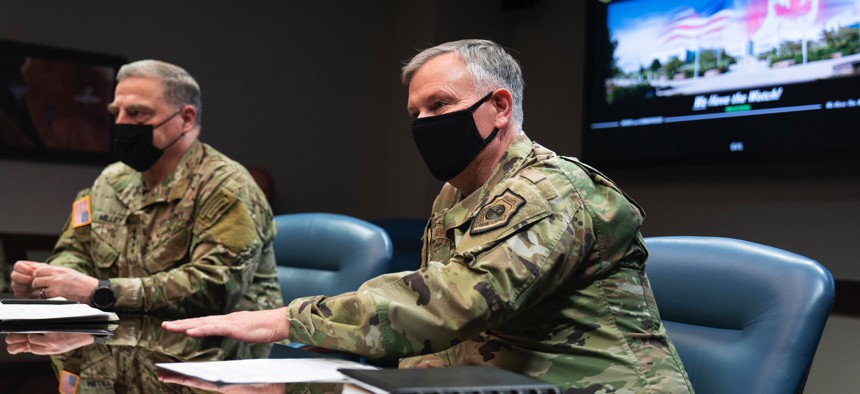
Gen. Mark A. Milley, chairman of the Joint Chiefs of Staff, and Gen. Glen D. VanHerck, commander of USNORTHCOM, talk at Peterson Air Force Base, Colorado Springs, Colo, March 1, 2021. DOD / Navy Petty Officer 1st Class Carlos M. Vazquez II
Key Elements Expected This Year for Pentagon’s Link-Everything Effort
A second NORTHCOM experiment aims to prove out various concepts for JADC2.
PETERSON AIR FORCE BASE, COLORADO—Several foundational elements of the Pentagon’s effort to network virtually all of its weapons, vehicles, and troops should fall into place this year, the chairmen of the Joint Chiefs of Staff said on Monday.
Among them is a new joint warfare concept to guide the services as they develop doctrine to take advantage of better networked forces, Gen. Mark A. Milley told reporters traveling with him. Milley said he would soon send the document to Defense Secretary Lloyd Austin and Deputy Defense Secretary Kathleen Hicks, and hoped to receive approval before he and Austin testify in upcoming congressional budget hearings.
Milley called it “Joint Warfighting Concept 1.0,” hinting at an expectation that the concept will change quickly in the light of more input, and said it will become the “intellectual foundation” for the force’s budgets and postures. He said he expected it to take several years for the services to turn the concept into doctrine that “sergeants and captains and colonels can actually apply” in operations.
“Concepts are used to develop doctrine, to develop organizations that will employ the doctrine and to do force development, force design for weapons systems that you will need to execute the doctrine,” he said.
In the meantime, U.S. Northern Command is continuing experiments into what JADC2 can help warfighters do. The first one wrapped in December; a second, larger one is planned for March 21-23, featuring multiple combatant commands, including Southern Command and Central Command, and functional commands such as Strategic Command and Transportation Command.
“What I’m trying to do with our Global Information Dominance Experiments is to show all the combatant commanders the value of information. The value of data and what we can actually do today if you apply technology that exists today to basically analyze data that previously we’ve analyzed in stovepipes and data had been left on the cutting room floor,” NORTHCOM commander Air Force Gen. Glen D. VanHerck told journalists here on Monday.
For example, VanHerck said, NORTHCOM’s Pathfinder initiative is applying machine learning to radar data, hoping to enable existing sensors to detect new types of weapons rather than create new ones as threats evolve.
U.S. Northern Command has been a leader in fusing large, disparate data streams and using machine learning and other AI techniques to analyze them and speed decision making in real-world operations. Last April, NORTHCOM forecast a spike in COVID cases in Stamford, Connecticut.
Such data fusion should get easier under the new Joint Warfighting Concept, Milley said: among his goals for the year is developing military-wide data standards across the military.
“It’s got to be a joint system that meets baseline standards that are common to all the services so by the end of this year, we want those standards that are common to all the services,” he said. “And we want the services to buy-in. And there’s huge amounts of money involved here, too. So it's pretty significant.”
It would also represent a fundamental change from the way the military has developed weapons and equipment.
“Up until today, all the services, for years, decades, have been developing their own internal systems,” Milley said. “And we end up having to do all these bridges and workarounds etc. So they optimize development for their own internal requirements and they sub-optimize for anything that’s needed for the joint role. But we don’t fight wars as an Army, a Navy…we fight wars as a nation and we fight wars with allies and partners.”




